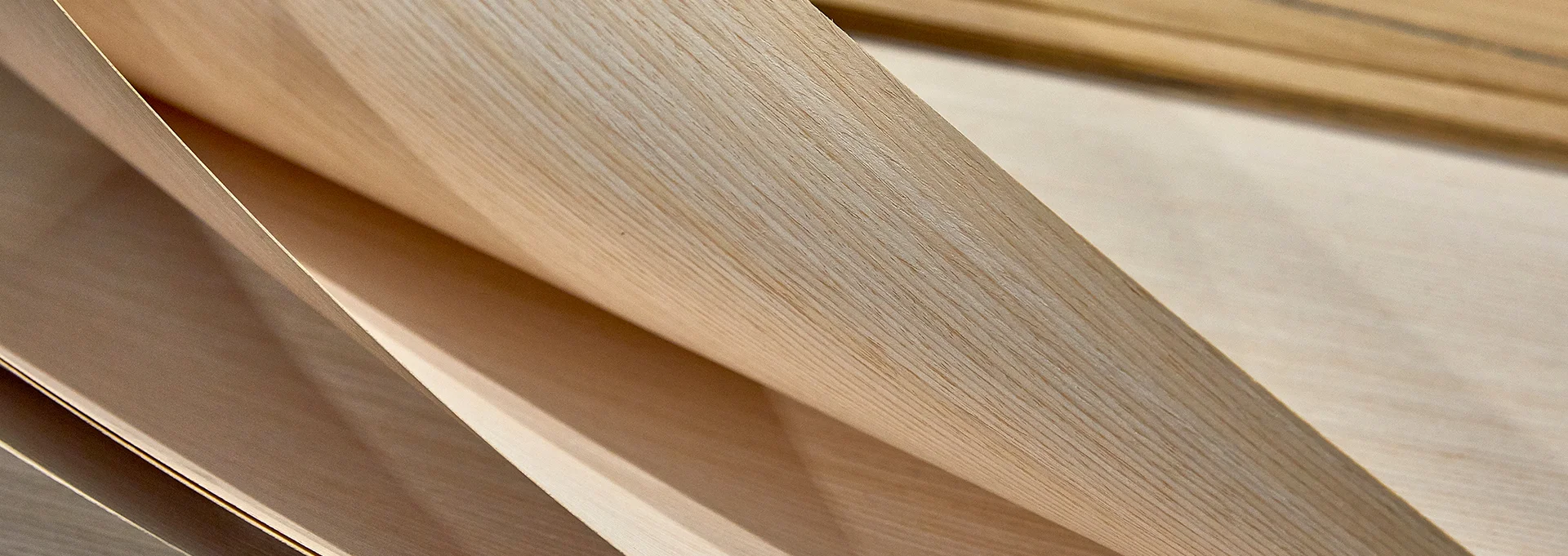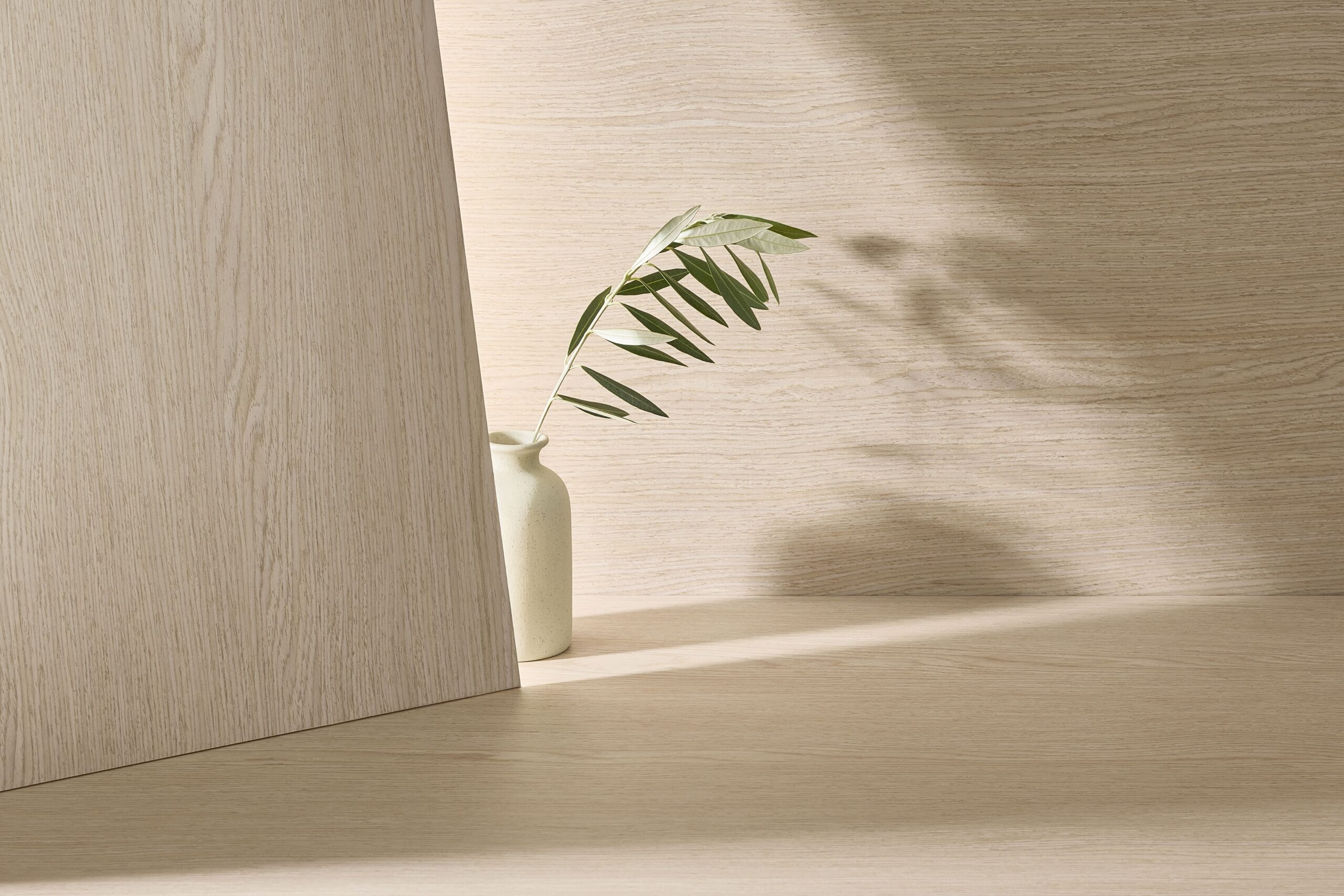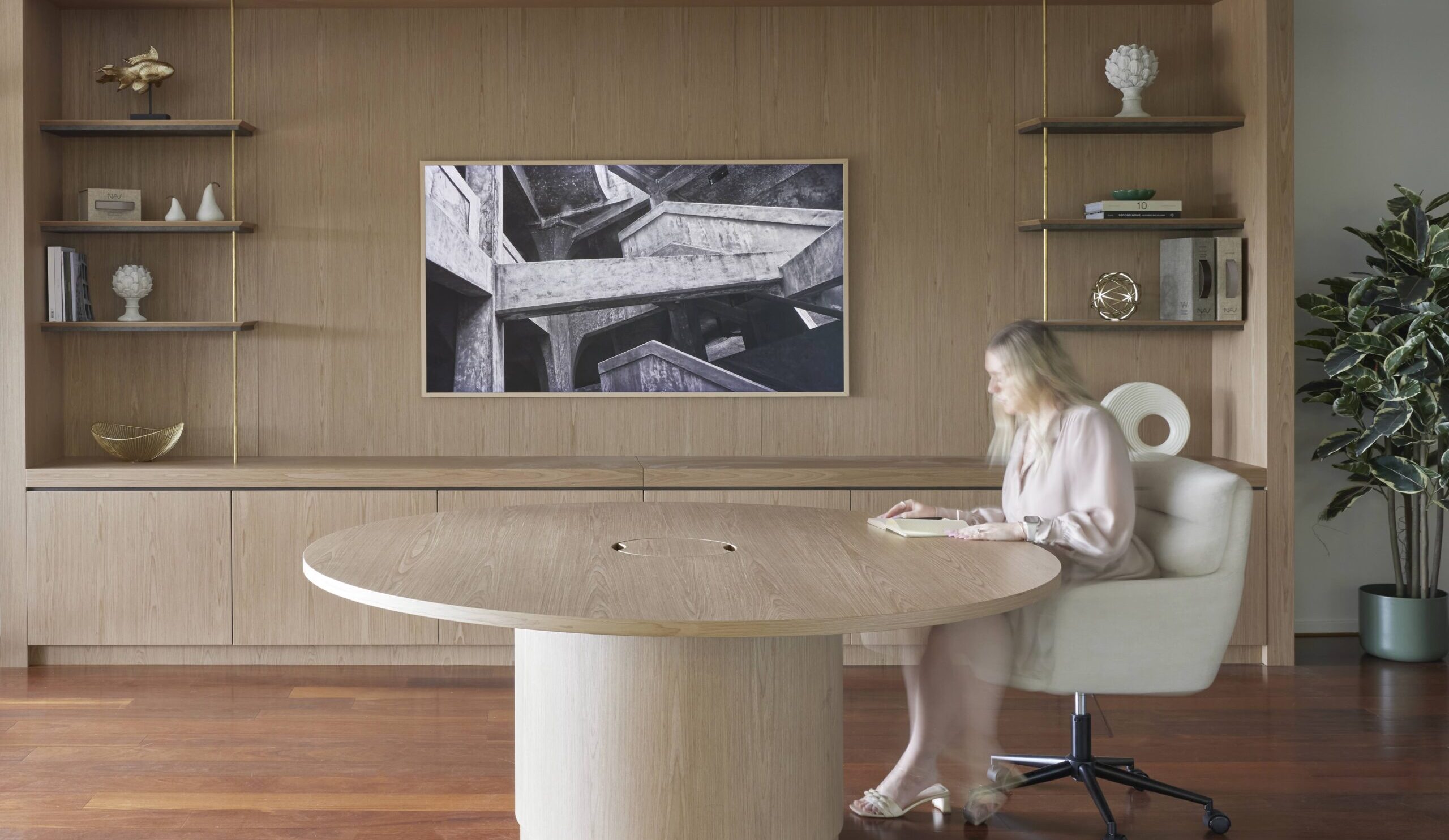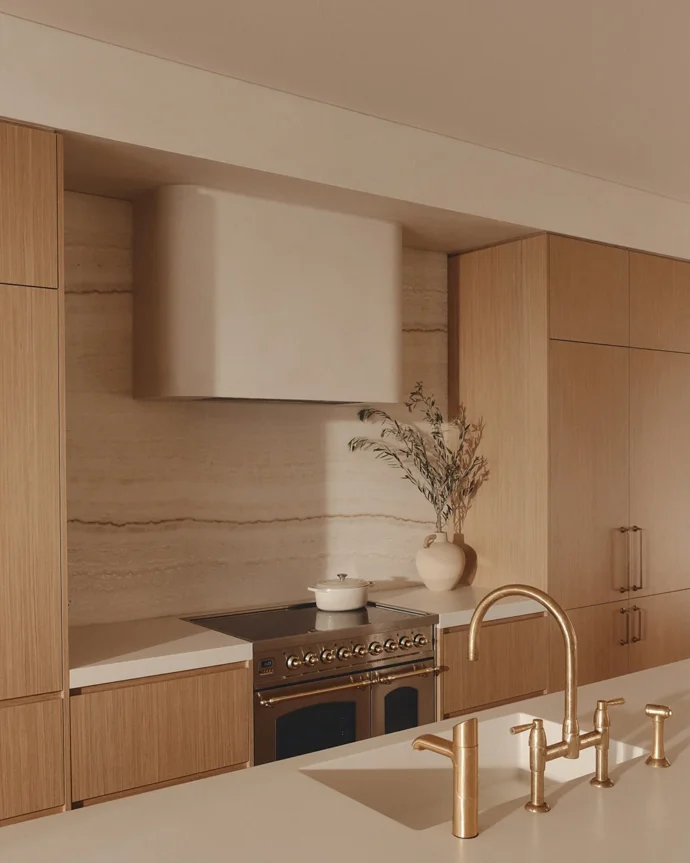
Timber Veneer for Commercial & Residential Use
A timber veneer is a decorative panel which is a thin layer, finely slices from a large wood block at an average thickness of 0.6mm.
Timber veneers are generally pressed onto a core substrate material such a E0 MR MDF. Reconstructed timber veneers are derived from natural wood veneers which are sliced and dyed to the colour desired by manufacturer, then re-glued in a block mould to create a consistent grain pattern. The blocks are then cut into layon thickness to result in a curated and unique range of reconstructed timber veneers.
A stunning variety of products
Explore our diverse product range and request your exclusive samples today.
Benefits of Reconstructed Timber Veneers
- Consecutive colour and grain pattern achieved with the manipulated of the reconstruction process of the timber veneers.
- A diverse range of colours and grains can be available.
- Ease of batch match and replacement of sheets
- Natural textures and tones used to tailor into every aesthetic.
- The warmth of a timber veneer can add an element of softness within every project.
- Flexibility of substrate choice and application to achieve numerous design possibilities.
- Matching edging made from the timber veneer to ensure exact match.
- New Age Veneers supply the timber veneer raw pressed onto substrate to customise the gloss finish desired.
Patterns of Reconstructed Timber Veneers

The distinctive grain appearance in timber veneer is a result of slicing through the growth rings of a tree. A reconstructed veneer may display natural features such as pinknots, gum, and mild indentations. These are not classed as defects but purely intrinsic features of the wood veneer and its processing. The angle at which the wood is sliced determines the unique visual characteristics of each veneer. Below are descriptions of the most common timber veneer cuts and grain patterns available:

Rotary Cut
This cut involves peeling a log or trunk of a tree in a continuous motion. It produces a wide and repeating grain pattern with natural variations. Rotary cut veneers often showcase prominent cathedrals, creating a warm and traditional aesthetic.
Quarter Cut
Quarter Cut In this method, the log is first quartered and then sliced perpendicular to the growth rings. Quarter cut veneers display straight grain patterns with an appealing straight and uniform appearance. They are popular for their elegant and timeless appeal.
Rift Cut
Rift cut veneers are obtained by cutting the log at a slight angle to the growth rings. This cut produces a linear grain pattern with minimal figureor cathedrals. Rift cut veneers offer a contemporary and sophisticated look, often sought after for modern interior designs.
Crown Cut
Also known as “flat cut” or “plain sliced,” crown cut veneers are obtained by slicing the log parallel to the growth rings. This method produces agrain pattern that showcases the natural characteristics of the wood, including cathedrals, curls, and flame-like figures. Crown cut veneers are versatile and widely used, offering a classic and traditional aesthetic.
Timber Veneer Australia distribution
New Age Veneers has in house manufacturing site located within Sydney. We can produce high-quality on-board products pressed onto various substrates such as E0 MR MDF, FR MDF, and additional specialties substrates. We can distribute nation wide within Australia and are proudly. We have a quick sped to market turn around to ensure you receive your pressed timber veneers efficiently and effectively.
Specification of our reconstructed timber veneers:
When placing an order for our reconstructed timber veneers, please specify the desired board size as well as thickness.
Good 1 Side (G1S)
When specify a G1S board this is provided with a BAMO (Backing at Manufacturers Option) which is generally a downgraded plantation oak or a similar toned downgrade veneer. This option is used for applications where the backing is not noticeable or seen such as cabinetry door fronts, wall panelling & internal shelving. Please note this specification of the veneers is completely determined by the manufacturers backing availability at time of order.
Good 2 Sides (G2S)
With a G2S specification this provided the selected veneer pressed onto both sides of the substrate of choice. This ensures a A/A grade sheets is provided and consistency with front & back timber veneers. G2S specification is used in applications where both sides are seen, used in high-quality doors, shelving and panelling installations.
Colour Consistency with Reconstructed Timber Veneers
Although NAVENEER™ is a reconstructed timber veneer, it retains similar colour and grain characteristics to natural timbers. As a result, subtle grain differences may be visible between block lots. Colour variation of ±10% may also be evident between block lots due to batch dyeing. Just like natural timber, it is impossible to guarantee complete colour consistency between production blocks. Prolonged exposure to excessive sunlight may cause timber veneers to undergo sudden and irregular colour changes and is therefore not recommended.
New Age Veneers Reconstructed Timber Veneers available:
New Age Veneers supplies the NAVENEERTM range of veneers. This range is made up of reconstructed timber veneers made from rotary peeled timber that is colour enhanced through a dyeing process. Reconstructed veneers are consistent in colour and pattern batch to batch. Our extensive industry research has resulted in the development of dyeing systems based on water cycles. The dyeing process is used to obtain the required colour shades for each sheet of veneer. Wood veneers are impregnated by immersion into steel tanks at controlled temperatures with the addition of soluble dyes made from an organic structure. The dyes contain no chrome or other heavy metals. NAVENEERTM is suitable for use as feature wall and ceiling linings, joinery, furniture, doors, as well as acoustic panelling.
We also supply a NAVLAMTM range which consistent of pre-finished reconstructed timber veneers with a sandblasted texture finish. NAVLAM SandblastedTM is a range of textured reconstructed timber veneers, finished with high quality, scratch and stain resistant 2-pac acrylic polyurethane finish and laid on a laminate back. The sandblasted texture is created through a wire brushing process to give a unique textural surface. NAVLAM SandblastedTM is available as a finished panel on E0 MR MDF substrate thickness of your choice.
What is Naveneer Timber Veneers?
NAVENEERTM is a range of reconstructed Timber Veneers made from rotary peeled timber that is colour-enhanced through a dyeing process. Reconstructed veneers are consistent in colour and pattern from batch to batch.
What is the recommended Timber Veneer finish?
We recommend finishing panels with BC Coatings ZILCH! Finish.
Available in:
UT405 Zilch! Super Matte (0-5%)
UT410 – Matte 10%
UT430 – Satin 30%
UT450 – Semi-gloss 50%
Zilch! has been specially formulated for New Age Veneers and is a 2-pac polyurethane containing both a non-yellowing agent and UV inhibitor. A UV inhibitor offers some protection against discolouration, but like all natural products, colour variation will occur over time.
What are the advantages of using the Timber Veneer range - Naveneer?
Supplied in standard sheet sizes for better yield
Even in colour and pattern, allowing for consistency across continuous sheets batch to batch
Matching veneer edging
Supplied raw to be able to customise the gloss finish
What structures are available for the Timber Veneers?
New Age Veneers has an extensive range of reconstructed Timber Veneers and a variety of structures and decors:
- Straight Cut
- Quarter Cut
- Strata Cut
- Crown Cut
- Rift Quarter Cut
- Crown Quarter Cut
What dyeing system is used in Reconstructed Timber Veneers?
Our extensive industry research has resulted in the development of dyeing systems based on water cycles. The dyeing process is used to obtain the required colour shades for each sheet of veneer. Wood sheets are impregnated by immersion into steel tanks at controlled temperatures with the addition of soluble dyes made from an organic structure. The dyes contain no chrome or other heavy metals.
Can I change the colour or structure of the Timber Veneer?
Each Timber Veneer within our ranges is meticulously curated to suit the market needs in colourings and structure. Unfortunately, we are unable to change the colour and structure of the Timber Veneer to custom requests.
What are Wood Veneer?
Wood veneers are thin slices of natural wood that are bonded to a substrate or surface to create the appearance of solid wood. They retain the natural beauty of wood while being more cost-effective and sustainable.
What are the recommended finishes for Wood Veneer?
Popular finishes for wood veneers include:
- Polyurethane (PU): For durability and a glossy or matte look.
- Oil-based finishes: To maintain a natural, rustic appearance.
- Lacquer: For a clear, protective layer that enhances the wood grain.
Choose a finish based on the project’s functional and aesthetic requirements.
What are the advantages of using Wood Veneer?
- Cost-effective: Offers the luxury of wood at a fraction of the cost.
- Sustainability: Reduces the need for solid wood, preserving forests.
- Versatility: Available in various textures, patterns, and colours.
- Lightweight: Easier to handle and install compared to solid wood.
What types of structures are available for Wood Veneers?
- Wood veneers are available in:
- Flat Cut: Highlighting a natural wood grain pattern.
- Quarter Cut: For a straighter and more consistent grain.
- Rift Cut: Known for linear patterns, ideal for modern designs.
Enquiry
Connect with
Our Specialists
Have a question or need assistance?
Please fill out the form below with your details and specific inquiry, and one of our specialists will get back to you promptly.
